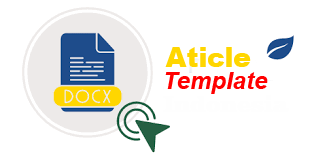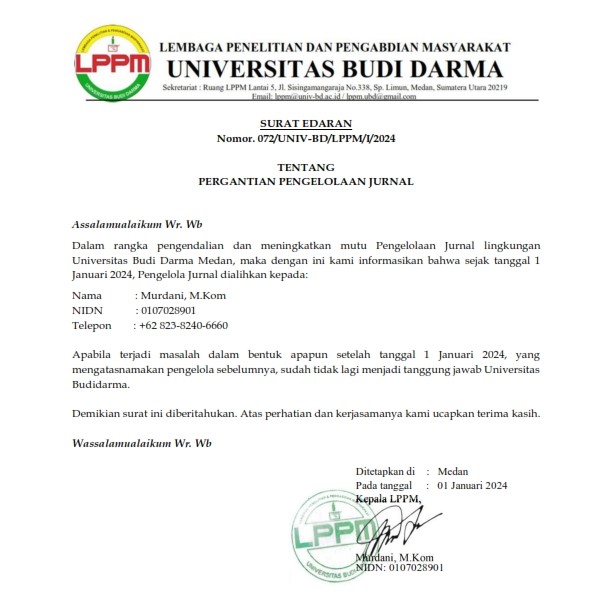Implementasi Sistem Informasi Geografis Dengan Metode Poligon Tertutup Untuk Menentukan Area Genangan Rob
DOI:
https://doi.org/10.30865/jurikom.v9i6.5101Keywords:
Layer, Rob, Pekalongan, Polygon, KMLAbstract
Pekalongan City is located on the north coast of Java Island and is in a lowland so it is prone to tidal disasters. Rob happened a few years ago, the longer it turns out that the more frequent and higher it is, this happens because of the massive land subsidence due to global warming so that sea levels rise. Land subsidence that occurs in Pekalongan, especially North Pekalongan, is classified as high per year around 10-34 cm. To solve the Rob problem The government built a giant embankment on the seashore that is expected to inhibit or reduce the rob. Areas that were originally affected by the tidal with the presence of this giant embankment can be reduced, including bandengan, Pasirsari, Customs, Panjang Baru, Panjang Wetan, Pasir Kramat Kraton and Slamaran villages. The problem in this study is that so far there has been no digital map that depicts the rob area and changes in the location of the rob area in the city of Pekalongan. This research was carried out using the Research and Development (R&D) method, a system development method using Waterfall. To describe the rob area using polygons and to depict the map using google earth, as for determining the coordinates of the location using Latitude and Longitude. Data collection using Observations, Interviews and Questionnaires. The purpose of this study is to make a Geographic Information System application mapping rob areas and their changes based on year criteria with Web-based multi-layer in Pekalongan City. The results of this polygon depiction are stored in a KML file and are expected to be a solution for structuring the area, especially the coastal part and for the community is expected to be better prepared to face disastersReferences
B. P. S. K. Pekalongan, “Kota Pekalongan dalam Angka 2019,†2019.
Z. I. Adlina, A. B. Sardjono, and S. R. Sari, “ADAPTASI PERMUKIMAN TERDAMPAK BENCANA ROB (Studi Kasus: Kelurahan Bandengan, Kecamatan Pekalongan Utara, Kota Pekalongan),†J. Arsit. ARCADE, vol. 3, no. 1, p. 21, 2019, doi: 10.31848/arcade.v3i1.201.
S. A. Iskandar, M. Helmi, S. Widada, and B. Rochaddi, “Analisis Geospasial Area Genangan Banjir Rob dan Dampaknya pada Penggunaan Lahan Tahun 2020 - 2025 di Kota Pekalongan Provinsi Jawa Tengah,†Indones. J. Oceanogr., vol. 2, no. 3, pp. 1--12, 2020.
S. Miftakhudin, “Strategi Penanganan Banjir Rob Kota Pekalongan,†J. Litbang Kota Pekalongan, vol. 20, pp. 29–38, 2021, [Online]. Available: https://jurnal.pekalongankota.go.id/index.php/litbang/article/view/142
A. Ardiansyah and K. Kardono, “Sistem Informasi Geografis (Sig) Pemetaan Jaringan Pipa Dan Titik Properti Pelanggan Di Pt Aetra Air Tangerang,†J. Ilm. FIFO, vol. 9, no. 1, p. 81, 2017, doi: 10.22441/fifo.v9i1.1445.
I. Setiawan, “Peran Sistem Informasi Geografis (SIG) dalam Meningkatkan Kemampuan Berpikir Spasial,†J. Pendidik. Geogr., pp. 733–744, 2014, doi: 10.1163/008555509X12472022364000.
I. T. Titin Umi Rahayu, Ahmad Syamsu Rijal S1, “Spatial Natural Tourism Potential Development of Bongo,†vol. 3, pp. 1–9, 2020.
R. Basaria, A. Setiawan, and E. Sediyono, “Penentuan luas wilayah kabupaten dan kota di provinsi sulawesi tengah menggunakan metode poligon dengan bantuan google earth Determination of regional areas of regency and city in central sulawesi province using polygon method by google earth,†RDE Dasar-Dasar Pengukuran Topogr., vol. 3, no. 1, p. 9, 2018.
I. Prasetyo, “Teknik Analisis Data Dalam Research and Development,†Tek. Anal. Data Dalam Res. Dev., vol. 6, p. 11, 2014.
E. W. L. Cheng, H. Li, and L. Yu, “A GIS approach to shopping mall location selection,†Build. Environ., vol. 42, no. 2, pp. 884–892, 2007, doi: 10.1016/j.buildenv.2005.10.010.
A. M. Torkashvand, A. Irani, and J. Sorur, “The preparation of landslide map by Landslide Numerical Risk Factor (LNRF) model and Geographic Information System (GIS),†Egypt. J. Remote Sens. Sp. Sci., vol. 17, no. 2, pp. 159–170, 2014, doi: 10.1016/j.ejrs.2014.08.001.
M. Zichar, “Geovisualization based upon KML,†vol. 3, no. 1, pp. 19–26, 2012.
S. Arifin, “Penyajian Dan Visualisasi Citra Ortho Satelit Landsat Produk Indonesia ’ S National Carbon Accounting System ( Incas ) Dalam Google Earth,†vol. 2013, no. Sentika, 2013.
Skempton and Hutchnson, “International Society for Soil Mechanics and Geotechnical Engineering (ISSMGE),†pp. 536–537, 1970, doi: 10.1007/978-3-319-73568-9_174.
M. Yanto, “Sistem Informasi Geografis Lokasi Perkebunan Disepanjang Garis Pantai Pesisir Selatan Berbasis Android,†J. Ilm. Media Sisfo, vol. 13, no. 1, p. 28, 2019, doi: 10.33998/mediasisfo.2019.13.1.586.
A. S. Drestanto, A. Indarjo, and M. Helmi, “Pemetaan Area Genangan Banjir Pasang Di Kawasan Lahan Budidaya Air Payau Kota Pekalongan Provinsi Jawa Tengah,†Diponegoro J. Mar. Res., vol. 3, no. 4, pp. 439–446, 2014, doi: 10.14710/jmr.v3i4.8365.
Kholil, “Pemanfaatan Sistem Informasi Geografis (Sig) Dalam Aplikasi Pelaporan Dan Pelacakan Kejahatan Berbasis Android the,†J. Teknol. Inf. Dan Komun., vol. 6, no. 1, pp. 51–58, 2017.
H. Rida Hilyati, Arief Laila Nugraha, “Jurnal Geodesi Undip Januari 2019,†vol. 3, no. 1, pp. 315–331, 2019.
B. Sutrisno and S. Renggiang, “Pemanfaatan Google Maps Dalam Pembuatan Peta Khusus Untuk Meningkatkan Ecoliteracy Peserta Didik,†vol. 3, no. 2, pp. 379–394, 2019.
M. Destiningrum and Q. J. Adrian, “Sistem Informasi Penjadwalan Dokter Berbassis Web Dengan Menggunakan Framework Codeigniter (Studi Kasus: Rumah Sakit Yukum Medical Centre),†J. Teknoinfo, vol. 11, no. 2, p. 30, 2017, doi: 10.33365/jti.v11i2.24.
F. Masykur, “Implementasi Sistem Informasi Geografis Menggunakan Google Maps Api Dalam Pemetaan Asal Mahasiswa,†J. SIMETRIS, vol. 5, no. 2, pp. 181–186, 2014.
F. Mahdia and F. Noviyanto, “Pemanfaatan Google Maps API untuk Pembangunan Sistem Informasi Manajemen Bantuan Logistik Pasca Bencana Alam Berbasis Mobile Web (Studi Kasus : Badan Penanggulangan Bencana Daerah Kota Yogyakarta ),†J. Sarj. Tek. Inform., vol. 1, no. 1, pp. 162–171, 2013.
S. Ain, E. Hayat, F. Toufik, and M. Bahaj, “UML / OCL based design and the transition towards temporal object relational database with bitemporal data,†J. King Saud Univ. - Comput. Inf. Sci., vol. 32, no. 4, pp. 398–407, 2020, doi: 10.1016/j.jksuci.2019.08.012.
M. M. Mkhinini, O. Labbani-Narsis, and C. Nicolle, “Combining UML and ontology: An exploratory survey,†Comput. Sci. Rev., vol. 35, p. 100223, 2020, doi: 10.1016/j.cosrev.2019.100223.








